Learn How to Do Tapestry Crochet With This Free Tutorial; Then Practice What You’ve Learned Using Your Choice of Free Tapestry Crochet Patterns
Want to learn how to do tapestry crochet? If so, grab your crochet hooks and some colorful yarns; this is the place to find free step-by-step tapestry crochet instructions, free tapestry crochet patterns, recommendations for the best tapestry crochet books, and lots of lovely tapestry crochet project ideas.
Tapestry Crochet Examples
When I’m learning something new, I find it helpful to see examples of the technique or concept being taught. You too? Great! Let’s start off this tutorial by taking a look at some examples of tapestry crochet work.
First up is a pair of tapestry crochet potholders that each feature a checkered diamond motif. In the tutorial below, I’m going to show you how to get started with crocheting these potholders.
In general, checkered patterns are some of the easiest tapestry crochet patterns you could ask for — because a checkerboard design is so predictable that, once you’ve established the pattern, it’s pretty intuitive to keep going with it. If you’ve never tried tapestry crochet before, an easy checkerboard would be a fantastic option for your first tapestry crochet project.
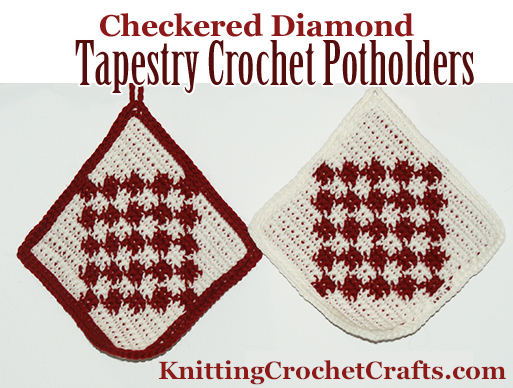
Pattern Sampler Afghan — Free Crochet Pattern
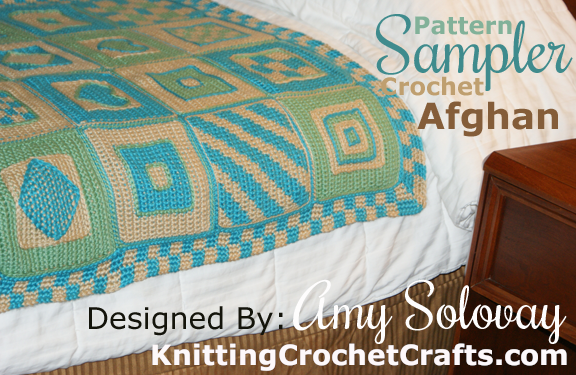
Some afghans make for fairly boring crochet projects, because you have to duplicate the same square motif over, and over, and over, and over again.
Not this one. Each square in this afghan pattern is different, which keeps the project interesting to work on.
It’s also possible to use any combination of these squares together to create your own customized blankets and afghans.
The patterns for these squares and the blanket are available for free right here on our website.
Christmas Tree Pillow and Blanket
I’ve combined and re-colored several of the same squares from the pattern sampler afghan to come up with a couple of completely different projects: a matching Christmas blanket and pillow. Free patterns are available for both of these designs.
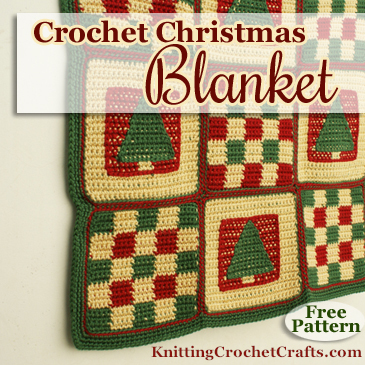
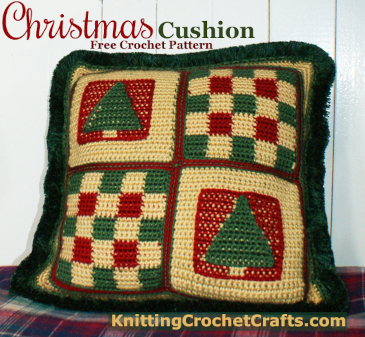
Tapestry Crochet Striped Heart Square
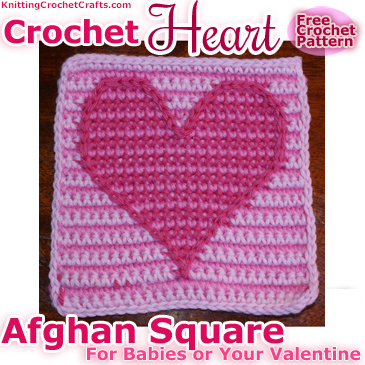
This heart square is one of my most-frequently-used crochet patterns; I’ve made bunches of different projects with it, and I’ve tried re-coloring the design in dozens of ways. It never fails to intrigue me. It works best when you use a dark, medium and light shade, with the darkest and medium shades being used inside the heart and the medium and lightest shades being used outside the heart.
Please don’t let this be your first tapestry crochet project; it’s an intriguing design, but not the easiest pattern to get started with.
So there you have a few different examples of tapestry crochet. If you already know how to do tapestry crochet, you can skip down a few sections to find even more free tapestry crochet patterns that are available on our website — plus suggestions for some truly outstanding crochet books that include additional tapestry crochet patterns and project ideas.
Read on if you want to learn how to do tapestry crochet and get a better understanding of the technique…
What Is Tapestry Crochet?
Tapestry crochet is a crochet colorwork technique that empowers you to create multicolored patterns without having to weave in zillions of loose ends. You’ve no doubt noticed by looking at the examples above that you can use tapestry crochet to create interesting motifs and shapes like trees, hearts and diamonds. It’s also possible to create some seriously complex pictorial designs using tapestry crochet.
What Kinds of Projects Can You Make With Tapestry Crochet?
Tapestry crochet is well suited to doing just about every type of project you can make using traditional crochet. The only caveat is that the work tends to be a bit denser and stiffer than comparable traditional crochet work made using the same size hook and yarn. So, tapestry crochet tends to be a bit better suited to making projects where density and stiffness are assets. It’s an ideal technique to use for making baskets, rugs, tote bags, hot pads, cat beds and things like that.
If you want to make a drapey, flowing fabric using this technique, it may be necessary to use a finer yarn than you ordinarily would expect to use.
Tapestry crochet also tends to produce a slightly warmer fabric as compared against traditional crochet worked with the same size hook and yarn. I particularly like using tapestry crochet to make blankets, because the resulting blankets tend to be extremely warm and cozy. If you live in an area where winters are harsh, that’s the ideal situation to be making tapestry crochet blankets for your family.
How Many Colors Can You Use in Tapestry Crochet?
The easiest tapestry crochet patterns use only 2 colors. In theory, I’m not aware of any limit on how many colors you could actually use in tapestry crochet; but, in practice, it gets more cumbersome to do the work as you add more colors per row. I enjoy working tapestry crochet patterns that have 3 colors per row. I haven’t ventured too far into doing patterns requiring more than 3 colors per row. I’m sure it could be done, but at that point, you’d be likely to end up with an excessively heavy, bulky and stiff fabric. You could maybe escape the density and stiffness by using finer yarns or threads with larger hooks than usual, but I haven’t tried that to verify for sure how it would turn out.
How to Do Tapestry Crochet: Free Step-By-Step Tapestry Crochet Tutorial
There are multiple approaches you can use for working tapestry crochet. You can crochet back and forth, in rows, turning the work in between. This is how I like to do it. In the following tutorial, I demonstrate how to do tapestry crochet in rows:
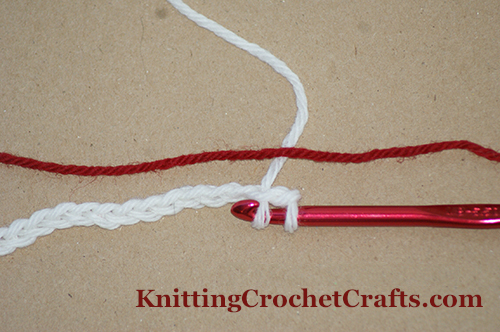
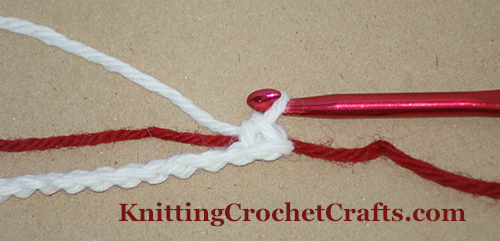
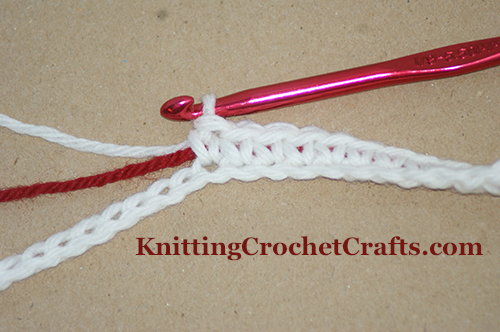
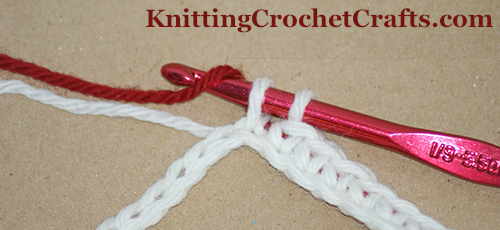
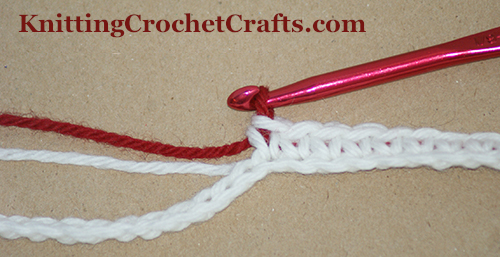
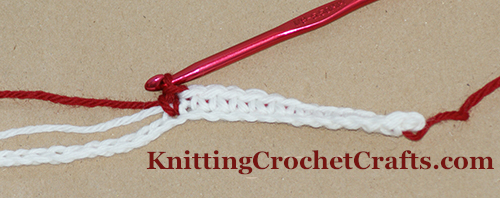
You can also work tapestry crochet in rounds, working only from one side of the fabric. The work tends to slant if you do it this way. For many patterns, the slant doesn’t matter, but it’s something to be aware of if you ever design your own tapestry crochet patterns because the slanting can affect the way the finished design looks.
You can also work tapestry crochet from only one side of the work, ending off your colors at each end. If you want to make a blanket, shawl, rug or other project with fringe at each end, this is a handy way to do it. Otherwise, I wouldn’t advise using this method, because it will leave you with zillions of ends to weave in. I learned about this option from Karen Ratto-Whooley’s excellent book called Fair Isle to Crochet, published by Leisure Arts.
More About Carrying the Yarn in Tapestry Crochet
In the example above, I began carrying the yarn right at the beginning of the project. This is what I recommend doing, even if you don’t need the carried color for the first row. I make this recommendation because carrying the yarn consistently helps to maintain an even tension throughout the piece.
When I was new to working tapestry crochet, I didn’t do this — and maintaining an even tension was the biggest problem I had with the technique. (My tension issues can’t entirely be blamed on the yarn-carrying issue; it just takes some practice to get used to. If you have tension issues in the beginning, just keep practicing until you work through them. They will go away with enough practice).
Not all crochet pattern designers write their patterns instructing you to carry the yarn from the beginning. To save yarn, some people will recommend not carrying the yarn until you absolutely need it.
Of course, it’s totally up to you to decide which way you want to do it. But be aware that I always carry the yarn from the beginning, and that’s definitely what I recommend doing if you use any of my tapestry crochet patterns.
Tapestry Crochet History + Another Name for Tapestry Crochet + Tapestry Crochet Used With Other Stitches and Techniques
Tapestry crochet dates back at least as far as the 1930s, and it may be even older. So far the oldest reference book I have in my library that makes any mention of this technique is a vintage Alice Brooks craft catalog from the 1930s. The folks at Alice Brooks referred to the technique as “Cameo Crochet”. There’s a photo accompanying the text, and the photo clearly shows the same tapestry crochet technique being used with double crochet stitches.
One important takeaway from this: You aren’t limited to using the tapestry crochet technique with only single crochet stitches. You can also use it with virtually any other crochet stitch or stitch pattern. Double crochet and half double crochet work beautifully with the tapestry crochet technique. Presumably, so would treble crochet, but I haven’t had a reason to try that yet to confirm it.
However, do be aware that the carried yarns are likely to show if you try to use the technique with lacy, open stitches.
Tapestry Crochet Granny Squares
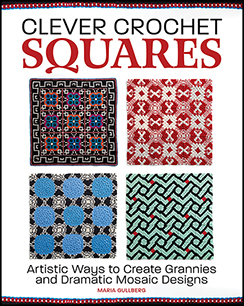
You can combine tapestry crochet plus granny squares to make some seriously cool grannies that are unlike anything else you’ve ever seen. That’s the topic of Maria Gullberg’s brand new crochet book called Clever Crochet Squares. This book incorporates international symbol crochet charts, which make it easy to understand where your color changes happen. If you enjoy granny squares, and you’d like to try incorporating some interesting colorwork into your grannies, this is a book you’re likely to enjoy.
I’m still in the process of reviewing this book, but I have read enough of it to feel confident in recommending it to you. In the meanwhile, you can learn more about this book at Amazon, where the book is available for sale.
Tapestry Crochet + Shallow Single Crochet
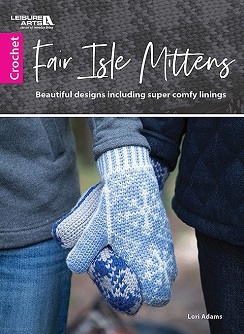
It’s possible to use the tapestry crochet technique along with the shallow single crochet stitch to create pieces that resemble Fair Isle knitting. Lori Adams elaborates on how to do this in her brand new book called Fair Isle Mittens. The mittens presented in this book all look knitted, but they aren’t; they’re totally crocheted.
This is an innovative and amazing book that I highly recommend. You can learn more about it in my detailed book review Here.
Practice Your Tapestry Crochet Technique With These Free Patterns:
In the example section posted above, all the projects are available as free crochet patterns (except the checkered diamond potholders, which I am still working on posting. I will update this page again when the free pattern is available.)
In addition to those, the following tapestry crochet patterns are available online for free:
Pattern Sampler Afghan Squares
Linked here is a list of square patterns from the pattern sampler afghan. You can combine these in zillions of different ways to make your own customized blanket, afghan, baby blanket, lapghan or throw — or, for that matter, any other type of project that could be constructed out of squares. Pillows and table runners are also possibilities.
Rainbow Tapestry Crochet Scarf — Free Pattern
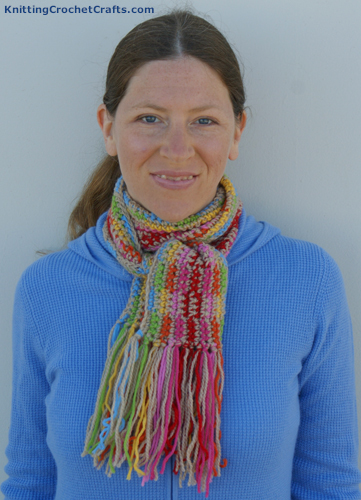
I LOVE rainbows! But it takes a special person to want to wear rainbows around, because they draw a lot of attention to themselves.
This scarf gives you the option to wear a rainbow without the rainbow of colors being totally obnoxious. You can use beige, tan, gray or your favorite neutral to tone down the rainbow effect, which makes this scarf ultra wearable.
Crochet Cupcake Potholders
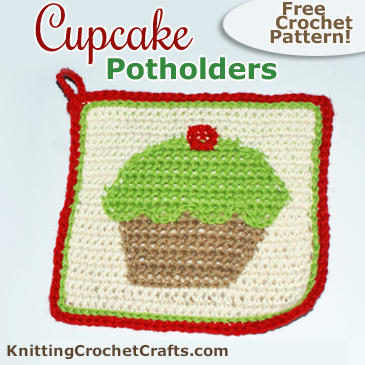
So far I’ve crocheted a couple different colorways of these cupcake potholders. Pictured below is a Christmas-friendly version you could use for holiday baking or giving as gifts to your friend. Not pictured, I also crocheted a pink version of this design that is delightful too. Of course, feel free to use any colors you like — colors to match your kitchen or any colors that you happen to have hanging around in your yarn stash.
Striped Crochet Heart Potholders — Free Pattern
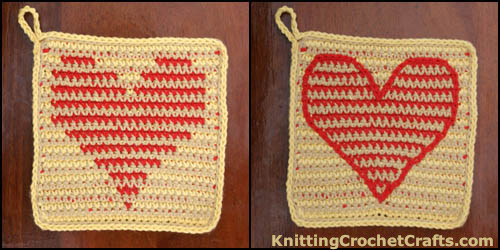
These potholders incorporate the same striped heart motif as one of the afghan squares pictured above.
Find More Excellent Tapestry Crochet Patterns for Sale
Crochetterie by Molla Mills
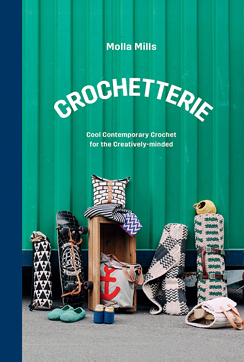
Crochetterie is a unique crochet pattern book featuring many different types of crochet projects, plus abundant step-by-step tutorials showing you how to do them. This book includes a whole bunch of different tapestry crochet patterns, plus a whole bunch of patterns worked in other crochet techniques.
One of the really fantastic things about this book: It is totally guy friendly, and many of the projects in the book are ones that guys might be inclined to use. So, if you’re a guy who wants to do tapestry crochet, or a lady who wants to work crochet projects for guys, you will not be left out of the fun with this book.
Learn More About Crochetterie
- Click here to see our detailed book review of this title.
- Click here to shop for this book at Amazon.
Fair Isle to Crochet by Karen Whooley
This pattern book features colorful afghan patterns you can crochet using the tapestry crochet technique. There are five patterns included in the book. I gave this book a five-star review; I think it is an outstanding book.
Crochet Master Class by Rita Weiss and Jean Leinhauser
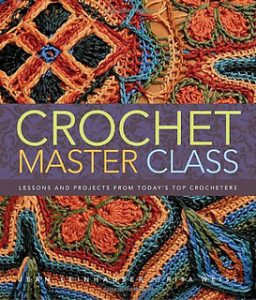
This book includes information about a variety of different crochet techniques; there is a section about tapestry crochet featuring a pattern by Carol Ventura. I own a copy of this book and highly recommend it!
So there you have it: That’s how to do tapestry crochet. Hopefully you now have everything you need to succeed with following tapestry crochet patterns and making the tapestry crochet projects of your choice. If you have questions about tapestry crochet, you’re welcome to leave a comment in the comments area below; if I know the answer, I’ll get back to you as soon as possible after. Thanks so much for your interest.
Find Our Picks for the Best Crochet Books:
- Best Crochet Granny Square Pattern Books
- Best Crochet Blanket Pattern Books
- Best Crochet Stitch Dictionaries
- Best Filet Crochet Pattern Books
- Best Crochet Books for Beginners
- Best Crochet Hat Pattern Books
- Best Crochet Patterns for the Home
Learn More About Crochet:
- Click Here to Learn How to Crochet; This Link Takes You to a Total Beginner’s Guide to Crochet.
- Click here to find crochet stitch tutorials and instructions.
- Click here to learn more crochet techniques.
- Click HERE to Find Fabulous Yarn for Crochet and Knitting
- Click here to learn about crochet hooks.
- Click here to find my favorite crochet project bag.
Learn About Other Crafts: Knitting, Sewing, Quilting, Paper Crafts and More
- Click here to get updated on the latest craft supplies.
- Click here to learn about knitting.
- Click here to find our beginner’s guide to knitting needles.
- Click here to find outstanding craft project ideas.
Posted By: Amy Solovay
Page last updated on 12-22-2022. Thanks for visiting!
OMG I’ve been wondering how people do this! THANK YOU, thank you, thank you! Awesome tutorial!
You’re welcome, Mary Kate! Glad you found the tapestry crochet tutorial helpful.
I loved learning about this crochet technique. Thanks for all the examples and patterns.
This tutorial is so helpful. Thank you.